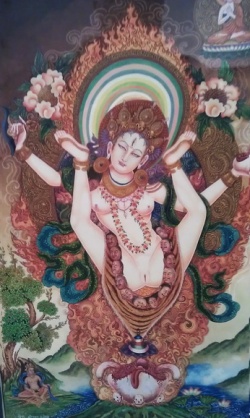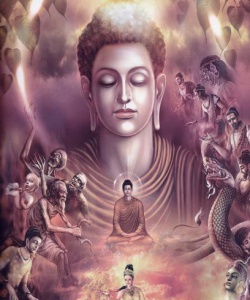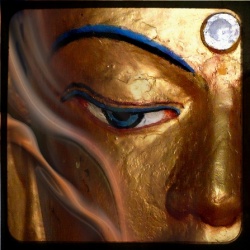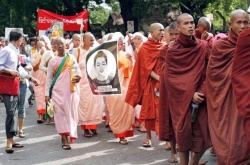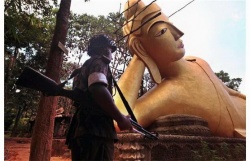Sanskrit and Buddhism
Sanskrit and Buddhism
In academia students of Buddhism are encouraged to study Sanskrit for even a basic understanding of the language is a substantial aid in understanding both Tibetan and Chinese texts. While the earliest Chinese
translations were based on non-Sanskrit Middle Indic texts, later on it was primarily Sanskrit. The Tibetans crafted much new language to reflect the Sanskrit texts which they generally faithfully translated.
In the present English speaking world a lot of commonly used Buddhist terms are Sanskrit like saṃsāra, dharma and nirvāṇa, though of course translations in some cases are more common like "sentient being" for
sattva. Theravāda Buddhists naturally use Pāli, though with everyone else there is a decided preference for Sanskrit terms, which are seen as original and default. In the absence of a standardized English Buddhist lexicon, I also prefer
using Sanskrit terms for their precision. However, Sanskrit as a language used to convey Buddhadharma was a somewhat later development in Buddhist history.
It seems sometime shortly after the start of the common era, the Buddhists of northwestern India under the Kuṣāṇas (30-375) adopted Sanskrit as their lingua franca. Prior to this there was a process of
sanskritization, most notably with Gāndhārī. Until such time Buddhists understandably used their own regional languages. These Middle Indic languages did not stem from Sanskrit, though in due
time plenty of people came to believe they in fact did. Nevertheless, it begs the question as to why then longstanding Buddhist traditions would feel compelled to adopt Sanskrit. The widespread adoption of Sanskrit for
inscriptions as well is reflected in the archaeological record, which Johannes Bronkhorst in his work Buddhism in the Shadow of Brahmanism notes as follows:
- For some four centuries, from the time of Emperor Aśoka (3rd cent. bce) onward, they used only Indo-Aryan languages other than Sanskrit. Sanskrit does not make its appearance in inscriptions until
the early centuries of the Common Era. Then it gradually takes over and becomes the inscriptional language par excellence in the whole of the South Asian subcontinent and much of Southeast Asia.[1]
Bronkhorst suggests that Brahmanism was able to secure long-term political influence and power in India in the face of other religious-social ideologies at the time because it offered not only useful priestcraft sought after by rulers, but also
because Brahmins offered both sound political advice and practical social theories. This is why much of the subcontinent came to adopt Sanskrit as a lingua franca. Until that time states and people, including
Buddhists, had little reason to use Sanskrit. He states, “Sanskrit was the archaic language of a group of people, the Brahmins, whom the Buddhists had no particular reason to imitate or please.”[2]
However, when Brahmins gained for themselves influence and power they also introduced Sanskrit which in turn ended up as the language of elites as reflected in the archaeological record. This is indeed why Indian Buddhism came to use
Sanskrit instead of other equally intelligible Middle Indic languages as it had before for several centuries. The emergence of vihāra systems (i.e., the vinaya-based monastic system) around the common era is what prompted Buddhist institutions to adopt a language suitable to their benefactors.
It seems conceivable that as monastic institutions grew and required steady sources of substantial income they depended more on the upper echelons of society rather than on common peoples. The Jains on the other hand relied more on common
peoples, which helps to explain their resistance to Sanskrit. In other words, Buddhism underwent a process of gentrification via the adoption of Sanskrit and the development of sophisticated monastic systems (in contrast to the homeless
mendicant lifestyle of many of their predecessors). The mundane matters related to dealing with brahmanized royal courts is what drove Buddhists to adopt the language of a community often hostile to them:
- They did not do so because they liked Sanskrit, or because they liked the Brahmins whose language it was. Nor did they do so for some inherent quality that this language supposedly possesses. They did so because they needed to defend their interests
at the royal courts in Sanskrit. They had to use Sanskrit at the courts because Brahmins had been able to secure themselves a central place at the courts by way of their indispensable skills, not because rulers had supposedly “converted” to
Brahmanism. This, as far as I can see, is the most plausible explanation of this otherwise puzzling change of language.[3]
Bronkhorst also suggests this helps to explain why several eminent and quite successful early authors like Nāgārjuna all hailed from Brahmin backgrounds. Having been born and raised in a Sanskrit environment and trained to write eloquently in said language, they were in a privileged position to become representatives of the religion. While many of their peers were
no doubt erudite, in the early centuries of the common era there was a pressing need to write in Sanskrit and this gave special opportunities to Brahmin born Buddhists. This incidentally also acted as a means through which Brahmin ethics
and ideas passed into Buddhist thought. One can clearly see this in such works as Vasubandhu's Abhidharmakośa-bhāṣya and the Upāsaka Śīla Sūtra which define sexual misconduct much the same way Kautilya's Arthaśāstra does where anything other than vaginal intercourse is defined as misconduct.
Proponents of the Vedas regarded Sanskrit as a divine language (daivī vāk) and in due time Buddhists who had adopted it likewise came to see it in a similar vein. Sanskrit became the original language from whence others emerged, and more
importantly was often regarded as the only correct language (interestingly Theravāda believed Pāli to be the original language, while the Jains believed it was their sacred language Ardha-Māgadhī).
It is notable some foreigners were convinced of this as well. At least one eminent Chinese monk of ancient times states that, as matter of fact, Sanskrit is the language of the gods. The famous pilgrim
monk and scholar Xuanzang (602-664) 玄奘, who visited India between 633-645, was quick to point out “accented” forms of the language that he disapproved of. The character e 訛 (meaning "accented") appears 93 times in his travel account the Record of Travels to Western Lands 大唐西域記. He describes the languages of India as follows:
- 《大唐西域記》卷2:「詳其文字,梵天所製,原始垂則,四十七言也。寓物合成,隨事轉用。流演枝派,其源浸廣,因地隨人,微有改變,語其大較,未異本源。而中印度特為詳正,辭調和雅,與天同音,氣韻清亮,為人軌則。隣境異國,習謬成訓,競趨澆俗,莫守淳風。」(CBETA, T51, no. 2087, p. 876, c9-14)
- Their letters were established by Brahma and have been passed down from their beginnings until now, being forty-seven in number. The combine to form words according to the object [declension?] and shift in use according to the action [inflection?]. It
has spread around and branched off, its source being deep and broad. Due to regions and peoples there have been some changes, though the words are generally not different from the original source. Central India is especially proper, their diction being elegant and the
same sound as devas with a character sharp and clear, which is a model for people. The neighboring countries have become accustomed to erroneous pronunciation. In their chaotic ways and base nature they do not maintain genuineness.
That last remark might stem from Bhartṛhari’s Vākyapadīya who noted the divine language had been corrupted by inept users. Xuanzang was a proficient user of Sanskrit and likely had access to the traditional
grammars in his study of the language. The frontier peoples speaking a bastardized version of the language is a reflection the widespread conception that all such dialects originally stemmed from a pristine divine source. Clearly Xuanzang believed this.
The script of Sanskrit itself came to hold especial significance in East Asia. The Siddhaṃ script in China and Japan was notably employed for esoteric practices. Xuanzang was, I assume, familiar with it. It became especially prominent
with the introduction of Mantrayāna into China in the 8th century. By the time Kūkai (774-835) arrived in 804 it was a widely studied script. Kūkai spent the early part of his stay in Chang'an studying Sanskrit at the monastery Liquan-si
醴泉寺 under the two Indian monks Prajñā and Muniśrī, knowledge of which he conveyed back to Japan. Even today in Japan the script is a core component of Shingon practices and art.
It is noteworthy that the script and Sanskrit vocabulary held great symbolic value for practitioners, though the grammar itself was not widely studied (prescribed grammar in East Asia was a largely alien concept
until the 19th century even with exposure to Sanskrit in ancient times, a topic I discuss here). However, Sanskrit phonetics did influence Chinese understanding of their own language. The famous polymath Shen Kuo 沈括 (1031-1095)
was aware even in his day of Sanskrit influences on Chinese linguistics. In his work the Dream Pool Essays 夢溪筆談 he states the following.
- 音韻之學,自沈約為四聲,及天竺梵學入中國,其術漸密。
- The methods for the study of phonetics have been gradually refined since Shen Yue 沈約 [441–513] dealt with the four tones and when Indian Sanskrit studies arrived in China.
Returning to India, at some point late in Buddhist history it seems there was a strong reaction against the entrenched widespread preference for Sanskrit, at least among some proponents of Vajrayāna. This was not unusual given the Vajrayāna propensity for practical adaptation and benevolent dissent. Vesna Wallace explains as follows:
- The author of the Vimalaprabhā declares that his reason for elaborately describing the characteristics of the kālacakra‐maṇḍala in the abridged Kālacakratantra, as they were taught by Mañjuśrī in the Ādibuddhatantra, is to eliminate the
self‐grasping (ahaṃkāra) of the sages who propound class discrimination (jāti‐vādin). The bearers of the Kālacakra tradition in India considered class prejudice as most intimately related to the Hindu doctrines of a personal god and
creator (Īśvara) and of an independent, inherently existent Self (ātman). They also saw class prejudice as creating the linguistic bias of extolling the excellence of the Sanskrit language and showing disdain for
vernacular languages. They were fully aware of the ways in which the Kālacakratantra's theoretical, practical, and linguistic features contradicted the cultural, religious, and social norms of the
mainstream Brāhmaṇical tradition. The Kālacakra literature interprets those features not only in terms of their conversionary activity and the Kālacakratantra soteriology but also in terms of the Kālacakratantra's social theory. It explains the grammatical inaccuracies and lexical syncretism of the Sanskrit
language of the Kālacakratantra as a: (1) skillful means of eradicating the conceit of those attached to their social class, knowledge, and proper words, and (2) skillful means of making the Buddhist tantric teachings accessible to a diverse audience, which speaks different languages and dialects. The Vimalaprabhā affirms that
individuals who are overcome by a false sense of self‐identity grasp onto the “single, parochial Sanskrit language” and teach, as attested by the Mahābhārata, 6, 1, 84, that a single word well‐pronounced yields one's desires in heaven. It accuses the Brāhmaṇic sages of writing the Dharmas of the Bhagavadgīta, Siddhāntas, and
Purāṇas in the Sanskrit language out of greed for material things. It asserts that Brāhmaṇas wrote these scriptures in Sanskrit in order to prevent the Vaiśyas, Śūdras, and other low social classes from reading their
scriptures and gaining knowledge of their Dharma and various sciences. The Vimalaprabhā states further that the Brāhmaṇic author of these scriptures knew that if lower classes were to gain knowledge, they would stop revering the
Brāhmaṇas for their special qualities. It contrasts the selfish motivation of the conceited Brāhmaṇic sages to the altruistic motivation of the Buddhas and Bodhisattvas, who are free of grasping onto social
discrimination and linguistic bias. The Buddhas and Bodhisattvas do not exclusively use the Sanskrit language to teach and redact the Buddhist teachings, for they also resort to the “omniscient language” (sarvajña‐bhāṣā), using the expressions of vernaculars and languages of different countries. Relying on the meaning of the teachings, they
use different vernaculars and different grammars in order to bring others to spiritual awakening. Although this characterization of the Buddhas' universal language is also found in the writings of Mahāyāna, it is most emphasized in the Buddhist tantras.
The Paramādibuddhatantra also advocates the usage of a lexically syncretized language that would benefit people of all social classes, ethnic groups, and mental dispositions. According to the Paramādibuddhatantra, the Buddha himself expressed this sentiment in the following words:
- When one understands the meaning from regional words, what is the use of technical terms?
- Likewise, the various redactors of my pure Dharma use diverse terms in accordance with the dispositions of sentient beings.[4]
Thus in due time there was a reaction in the opposite direction whereby at least some Buddhists rejected the preference for Sanskrit and perhaps more striking Brahmanization. Given the late period of the Kālacakratantra (circa early 11th
century, see page 65 here), this is especially noteworthy because Buddhism in India had already fallen into a long period of decline and decay. Even three centuries prior pilgrims like Xuanzang and Hyecho 慧超 (704–787) reported the Buddhist holy sites like Kushinagar and Kapilavastu as desolate ruins. As I discussed in an [[Revisiting Ancient
Buddhist India|earlier post]], I suspect by the time Xuanzang and Hyecho visited said holy sights Buddhism had long since been in a state of decay in India. If there were either pious devotees or large numbers of monastics they should have been able to maintain the sights, but instead they were described as largely abandoned.
A few centuries later the Kālacakratantra emerged in an environment where Buddhism was even further along in its decay, to say nothing of dominant Hindu ideologies and the invasions into India from the west. It was there that
polemical remarks were directed at rival ideologies coupled with an attempted iconoclastic movement against the Sanskrit monopoly. Whether it succeeded or not, it does speak to concerns at the time and an awareness among some about class struggle and discrimination which the proponents of the Kālacakratantra sought to remedy.
It seems Sanskrit Buddhism still retained its heavily brahmanized form in India until its final demise. Sanskrit Buddhism was lost in India, but preserved in the Kathmandu Valley in Nepal. It was in 1824 that the British
diplomat Brian Hodgson found numerous Sanskrit Buddhist manuscripts there. The study of Sanskrit Buddhist texts continues to the present day, and much importance is placed upon them for Mahāyāna Buddhists who look to India as the mother from whence their traditions were born.
However, when we consider the history of brahmanization of Buddhism on the subcontinent and all the heterodox influences that inevitably came with it, many questions and perhaps doubts will emerge in
respect to doctrine and legitimacy which need to be honestly addressed. This is not to say thing we should actively seek out and identify influences from Brahmanism and then purge them, but simply discuss their value and source, and then naturally move on,
much like how we examined Buddhism and Confucianism. In the future perhaps we can look more closely at some of the influences from Brahmanism on Buddhism.
Footnotes
